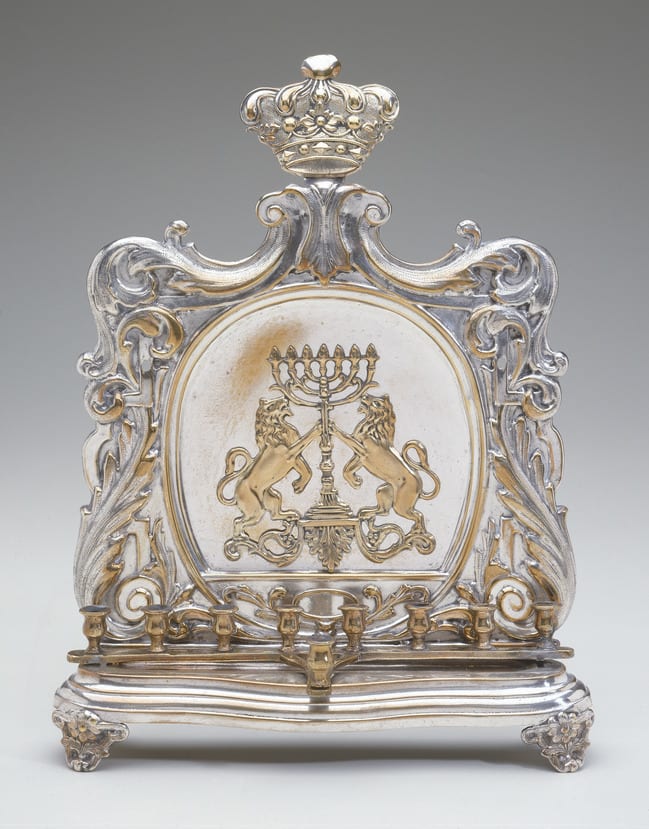
- Object Name:
- Hanukkah Lamp
- Manufacturer:
- Bracia Henneberg
- Bio:
- 1868-1961
- Place Made:
- Warsaw (Poland)
- Date:
- 1868-early 20th century
- Medium:
- Copper alloy: die-stamped, silver-plated, and appliqué
- Dimensions:
- 12 3/4 × 9 1/2 × 3 5/8 in. (32.4 × 24.1 × 9.1 cm)
- Credit Line:
- Gift of Dr. Harry G. Friedman
- Accession Number:
- F 1643
Not On View
The mass production of Hanukkah lamps that occurred in Germany and Austria with the popularity of the die press also spread to eastern Europe. Warsaw, in Congress Poland, was a major center of production in the late nineteenth century, a time that witnessed the rise of important factories like Fraget, Norblin, and Pogorzelski.
These various workshops produced large numbers of Jewish ceremonial objects; they used similar models and even exchanged parts. This assembly-line production, with specialization in particular backplate or appliqué designs by one or two makers, was probably a cost-saving device that enabled the mixing and matching of backplate and center decoration. Another means of decreasing expenses was to produce the lamps in copper alloy with a silver-plate finish. Years of loving polishing by owners often caused the plating to wear away in places, as has occurred on this example.
In the late nineteenth century, when so many of these lamps were being made, Warsaw was home to the largest Jewish community in the world. Although some Jews achieved financial success in commerce, banking, and industry, the majority were shopkeepers, artisans, and laborers. These silver-plated, stamped Hanukkah lamps would have been more affordable to this populace.
This lamp is particularly treasured as it belonged to the mother of Dr. Harry G. Friedman, the collector who donated most of the Hanukkah lamps in the museum's collection.
These various workshops produced large numbers of Jewish ceremonial objects; they used similar models and even exchanged parts. This assembly-line production, with specialization in particular backplate or appliqué designs by one or two makers, was probably a cost-saving device that enabled the mixing and matching of backplate and center decoration. Another means of decreasing expenses was to produce the lamps in copper alloy with a silver-plate finish. Years of loving polishing by owners often caused the plating to wear away in places, as has occurred on this example.
In the late nineteenth century, when so many of these lamps were being made, Warsaw was home to the largest Jewish community in the world. Although some Jews achieved financial success in commerce, banking, and industry, the majority were shopkeepers, artisans, and laborers. These silver-plated, stamped Hanukkah lamps would have been more affordable to this populace.
This lamp is particularly treasured as it belonged to the mother of Dr. Harry G. Friedman, the collector who donated most of the Hanukkah lamps in the museum's collection.
Information may change as a result of ongoing research.